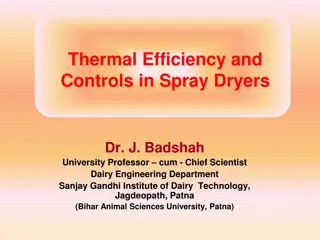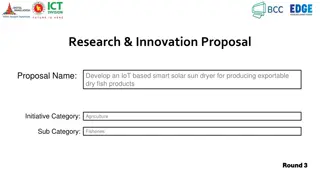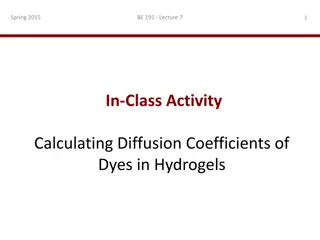Estimation of Drying Time in Spray Drying Process: Diffusion and Falling Rate Periods
The estimation of drying time in a spray drying process involves understanding diffusion-controlled falling rate periods, constant rate periods, and the mechanisms by which moisture moves within the solid. The drying rate curves depend on factors like momentum, heat and mass transfer, physical properties of the food, and the macro and microstructure of the food product. Various equations and laws are used to estimate drying times during different stages of the process, taking into account factors such as diffusion coefficient, boundary conditions, water vapor transfer rate, humidity ratio, and latent heat of vaporization.
Download Presentation

Please find below an Image/Link to download the presentation.
The content on the website is provided AS IS for your information and personal use only. It may not be sold, licensed, or shared on other websites without obtaining consent from the author. Download presentation by click this link. If you encounter any issues during the download, it is possible that the publisher has removed the file from their server.
E N D
Presentation Transcript
Estimation of Drying Time with diffusion controlled falling rate period of spray drying Process Food Engineering (DTE - 321) Dr. J. Badshah University Professor cum - Chief Scientist Dairy Engineering Department Sanjay Gandhi Institute of Dairy Science & Technology, Jagdeopath, Patna (Bihar Animal Sciences University, Patna)
Drying Rate Curve: Constant, Falling and Diffusion controlled period curve The form of drying rate curves depends on Momentum, heat and mass transfer, physical properties of the food, air and water vapour mixtures, and macro and microstructure of food product. Importance of mechanism mechanism by which moisture moves within the solid.
Drying Time during Diffusion controlled falling rate Period Moisture diffusion inside a solid expressed by Fick s law w/ t = D [ 2w/ r2 + j/r w/ r] D = Diffusion coefficient j = 0 for an infinite slab geometry j = 1 for an infinite cylinder j = 2 for a sphere Considering the droplet as spherical geometry, the solution under following boundary condition is At centre, w/ r = 0, r =o and t 0 At EMC of drying, W = we , r = R and t > 0 At initial stage from CMC, W = wc , 0 r R and t = 0 (wc- w)/(wc-we) = 1- 6/ 2 exp [-Dn2 2t/R2] tF = R2/ 2 D ln [6/ 2(wc we) /w we)], if n= 1(neglecting other terms of series)
Drying Time during Constant Rate Period Constant rate drying time in terms of water vapour transfer rate i. Water vapour transfer rate = Nc ii. Nc= km A Mw P (ws - wa )/0.622 R TA iii. km = Mass transfer coeff. in m/s iv. A = Surface area of product v. Mw = Molecular weight of water vi. P = Atmospheric Pressure in Kpa vii. TA = Absolute Temperature in Kelvin viii. R = Gas Constant = 8314.14 m3 Pa/Kg mole . K ix. Wa = Humidity ratio of air in Kg of water/kg dry air x. Ws = Humidity Ratio at Product surface = Kg of water /kg dry air xi. Constant Rate drying time tc = (wo wc)/ Nc Therefore keeping Nc, we have drying time (tc) in terms of water vapour transfer rate i. tc = 0.622 R TA (wo wc)/ km A Mw P (ws - wa )
Constant rate drying time in terms of Latent heat of vapourization at wet bulb temperature of surface Let HL = Latent heat of vapourization at wet bulb temperature of surface, in J /kg moisture Equating Rate of mass transfer rate (Nc) with rate of convection heat transfer (Q) we have : Q = Nc HL = h A ( TA Ts ) Joule/second Nc = h A ( TA Ts ) /HL As tc = (wo - wc )/ Nc Therefore, tc = HL(wo - wc)/ h A ( TA Ts ) Therefore, Constant rate Drying Time tc equations: tc = 0.622 R TA (wo wc)/ km A Mw P (ws - wa ), and tc = HL (wo - wc )/ h A ( TA Ts ) h = K/ R and A = 4 R2 , where K = thermal conductivity of droplet surface given by two
Drying Time in single Falling Rate Period of drying from CMC to EMC Consider the falling rate drying curve follow the straight line equation as follows: a. NF = aw +b b. d NF = a. dw +0 = a . dw c. dw = d NF /a d. If NF = - dw /dt e. dt = - dw/ NF = - 1/a d NF / NF f. Keeping limit of drying time from 0 to tF when Drying rate varies from Nc to NF g. Therefore, tF = - 1/a ln (NF / Nc ) = + 1/a ln ( Nc / NF), where h. a = d NF / dw = (Nc - NF ) / (wc w) = Nc / wc , when NF =0 at w = 0 As NF = a w and Nc = a wc, because intercept b =0 at x axis and we can write Nc / NF = wc /w Therefore, tF = wc / Nc ln (wc / w) Therefore Total drying time t = tc + tF in two stage of drying t = (wo wc)/ Nc + wc / Nc ln (wc / w)
Total Drying Time including diffusion controlled falling rate period Total drying time in three stage of spray dying rates: Constant Rate Period First Falling rate period without diffusion controlled but capillary movement controlled Second Falling Rate Period with diffusion controlled period Total Drying time t = tc + tf1 + tf2 tc = HL (wo - wc)/ h A ( TA Ts ) tc = HL (wo - wc)/ (K/R) 4 R2 ( TA Ts ) tf1 = wc / Nc ln (wc / w1) tf2 = R2/ 2 D ln [6/ 2(w1 we)/( w we)]























